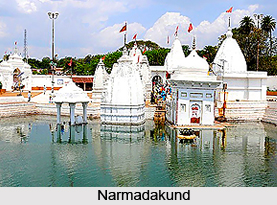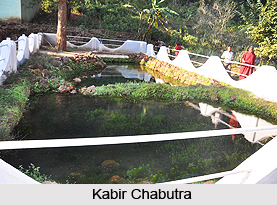 Amarkantak, situated in the Maikal Hill is an important pilgrimage centre for Hindus. It is situated at the confluence of two holy rivers, Narmada River and Sone River. Narmada is considered one of the most sacred rivers of India all with her strong asset as the daughter of Lord Shiva. It is also the meeting point of the Vindhyas Mountain Range and the Satpura Mountain Range in Central India. Amarkantak being a unique natural heritage comprises of a number of places of scenic beauty. Amarkantak is also famous for its temples that are visited by thousands of devotees from all the corners. Some of the famous temples in Amarkantak are:
Amarkantak, situated in the Maikal Hill is an important pilgrimage centre for Hindus. It is situated at the confluence of two holy rivers, Narmada River and Sone River. Narmada is considered one of the most sacred rivers of India all with her strong asset as the daughter of Lord Shiva. It is also the meeting point of the Vindhyas Mountain Range and the Satpura Mountain Range in Central India. Amarkantak being a unique natural heritage comprises of a number of places of scenic beauty. Amarkantak is also famous for its temples that are visited by thousands of devotees from all the corners. Some of the famous temples in Amarkantak are:
Narmadakund and Temples
At the place of origin of Narmada River there is an open pool known as Narmadakund. There are number of temples around this kund such as Narmada and Shiva temple, Kartikey temple, Shri Ram Janki temple, Annapurna temple, Guru Gorakhnath temple, Sri Shuryanarayan temple, Vangeshwar Mahadev temple, Durga temple, Shiv Pariwar, Siddheswar Mahadev temple, Sri Radha Krishna temple, Eleven Rudra temple and others.
Ancient Temples of Kalachuri Period
The ancient temples of Kalachuri period are located in the south of Narmadakund just behind it. These were built by Kalachuri Maharaja Karnadeva (1042-1072 AD). The Machhendranath and Pataleshwar temples are excellent examples of architecture. There is also Keshav Narayan temple built by the Bhonsle ruler of Nagpur in the 18th century.
Kabir Chabutra
Kabir Chabutra is a holy place where Saint Kabir believed to have spent many years in meditation to attain new heights of spiritual power. This place near Amarkantak is a holy place for Sant Kabir Panth sect.
 The local people, the Panikas, consider Kabir Chabutara as one of the holiest places of the Kabir Panthis because Saint Kabir spent many years here in meditation. This place is the meeting point of Kabir and Guru Nanak who discussed about various spiritual matters and introduced the way of better living for human being. It is also the meeting point of three districts, Anuppur and Dindori districts of Madhya Pradesh and Bilaspur district of Chhattisgarh. There is also a waterfall here known as Kabir waterfall.
The local people, the Panikas, consider Kabir Chabutara as one of the holiest places of the Kabir Panthis because Saint Kabir spent many years here in meditation. This place is the meeting point of Kabir and Guru Nanak who discussed about various spiritual matters and introduced the way of better living for human being. It is also the meeting point of three districts, Anuppur and Dindori districts of Madhya Pradesh and Bilaspur district of Chhattisgarh. There is also a waterfall here known as Kabir waterfall.
Shri Jwaleshwar Mahadev
The Jwaleshwar Mahadev temple and the source of origin of the third river Juhila River is located at Amarkantak at a distance of 8 km. The temple is located on the Shahdol road. According to `Vindhya Vaibhav` Lord Shiva himself established a Shivling here. He is also said to have established many other Shivlings over Maikal Mountain. According to puranic traditions a rectangular area containing crores of Shivlings is known as `Maha Rudra Meru` and is the abode of lord Shiva himself. There are only two `Maha Rudra Meru` places Varanasi and Amarkantak.
Shri Sarvodaya Digamber Jain Temple
Shri Sarvodaya Digamber Jain Temple is considered as one of the world`s biggest ashtadathu Jain idol of Bhagawan Adinatha. The temple at Amarkantak resembles the Aksharadhama temple of Gujarat. The temple has been designed and built under the supervision of Sri C.B.Somapura the Chief architect of the Akshardham Temple.





















